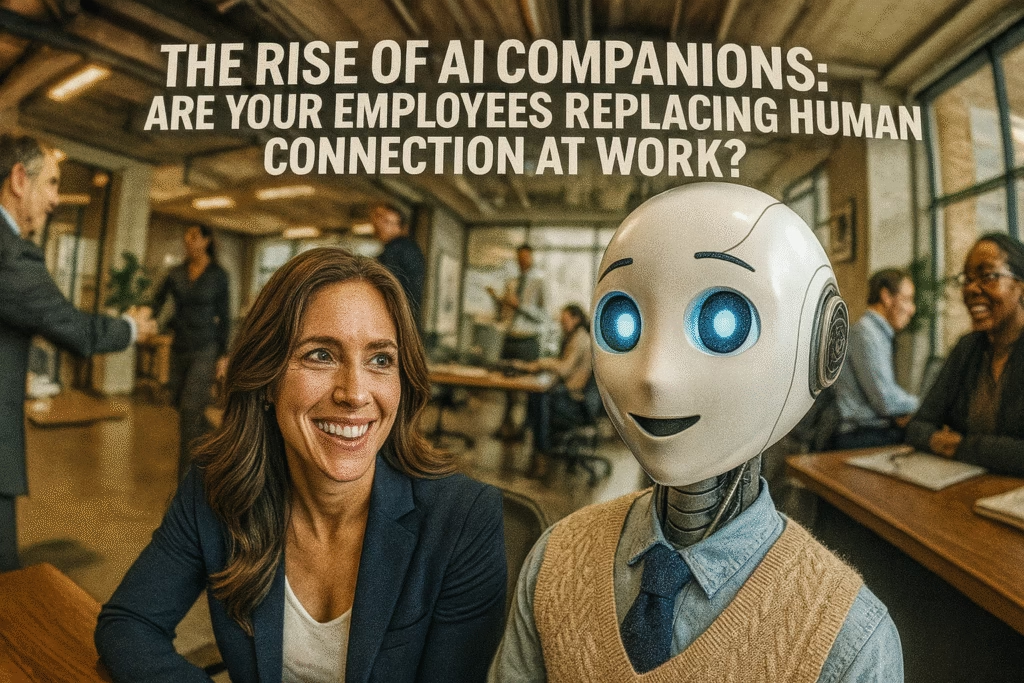The AI Mirage: What Your Team Is Really Telling You
In today’s hyper-connected, yet paradoxically disconnected, workplace, a fascinating and concerning trend is emerging: employees are turning to artificial intelligence (AI) assistants for support that transcends mere task management. This isn’t just about productivity hacks; it’s a glaring signal about unmet emotional needs within your organization.
Forget the hype about AI replacing jobs. The real story? AI is stepping into a void that humans should be filling. When your team finds solace in algorithms, it’s not innovation; it’s an indictment of your current workplace culture.
Beyond the Screen: Why We Crave Genuine Connection
Think about it: who ever thought a digital assistant would become a confidante? Yet, here we are. Employees are “collaborating” with AI, not just for spreadsheets, but for a form of emotional support often absent in human interactions at work. This reveals a profound craving for connection, amplified by the isolation of widespread remote work.
Remote work promised freedom, but often delivered a double-edged sword of flexibility mixed with profound loneliness. The buzz of the office is gone, but the human need for interaction persists. When nostalgia for genuine human connection isn’t enough, people turn to the quick, accessible comfort of AI. It’s a temporary fix, not a solution.
The Illusion of Digital Proximity
Consider tools like Slack and Zoom. Designed to foster camaraderie, they often devolve into sterile, transactional exchanges. Quick messages, urgent tasks, stock responses. When genuine interactions—the kind that build trust and rapport—are lacking, it’s easy to lean on clever AI tools that offer an illusion of care, minus the judgment or distraction often present in human relationships.
The Cost of Disconnection: What You’re Losing
This isn’t about employees preferring AI over people. It’s about fundamental emotional needs going unmet. Your team isn’t looking for transactional interactions; they’re starving for authentic moments of connection. Many leaders mistakenly believe more team meetings or generic “well-being” programs are the answer. They’re not.
Authentic support isn’t generated from digital feedback cycles; it stems from real conversations, empathy, and vulnerability. When employees feel disconnected, AI offers a convenient, temporary comfort. But this masks deeper systemic issues within team dynamics, eroding psychological safety and true collaboration.
The Trap of Convenience Over Connection
AI tools are evolving: voice mimicry, emotion analysis, personalized responses. They simulate human interaction. But this simulation is a hollow substitute for the nuanced complexity of genuine human connection. AI is a tool to assist, not a friend to confide in. Relying on it as a surrogate for presence is like drinking diet soda when you’re truly thirsty. It feels like something, but it’s not the real thing.
When your team seeks validation or acknowledgement from an algorithm, you have to ask yourself: What are you failing to provide in real life? The silence from your team might not be satisfaction; it might be the calm before a storm of disengagement.
Stop Managing, Start Leading: Building Authentic Workplace Culture
If your employees are turning to AI because they feel unheard or overlooked, that’s not an AI problem; it’s a leadership problem. Instead of investing in fancy management platforms or elaborate well-being tools that don’t fix the core issue, embrace simplicity. Embrace humanity.
- Ask real questions: “How are you really doing?” “What brings you joy at work?” These aren’t corporate clichés; they are invitations to connect.
- Listen actively: Don’t just wait for your turn to speak. Truly hear what’s being said, and what’s not being said.
- Create moments of authentic connection: A spontaneous compliment, a collaborative pause for reflection, a shared laugh. These are the building blocks of morale and trust.
AI provides instant responses, but it cannot replicate empathetic human presence. When interactions become automated, the very essence of what makes a team thrive — empathy, trust, shared understanding — slips through the cracks.
The Leader’s Imperative
This is your call to action. Authentic human engagement ignites motivation, stimulates creativity, and lays the foundation for a truly healthy work environment. Yes, AI can provide support; it can handle tasks. But the richness of human relationships? That is irreplaceable. Leaders must recognize that sacrificing genuine relationships for the sake of convenience or perceived efficiency is a catastrophic mistake.
As AI becomes an everyday fixture, the critical question isn’t “How much AI can we implement?” It’s “Why are employees turning to AI for connection in the first place?” Address the underlying emotional needs and dynamics within your team. That’s how you prevent the erosion of your most valuable asset: your people and their ability to connect.
Your Playbook for Real Impact: The Future of Human-Centric Work
Navigating the intersection of AI and human connection isn’t a tightrope walk; it’s a strategic imperative. In our technology-driven world, we must actively prioritize authentic interactions. The rise of AI companions isn’t a sign of progress; it’s a diagnostic tool, revealing critical gaps in your workplace culture and leadership.
Your goal isn’t just productivity; it’s to cultivate an environment that nurtures genuine camaraderie, supports individual growth, and fosters deep, lasting trust. Combine strategic technology adoption with unwavering commitment to humanity. Because at the end of the day, it’s the shared moments of laughter, understanding, and real human connection that drive true impact. It’s the people we remember, not the pixels. Build a culture that matters.




